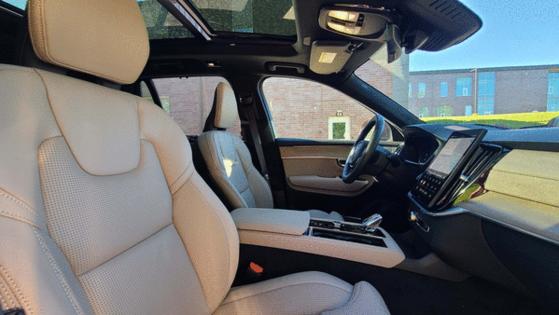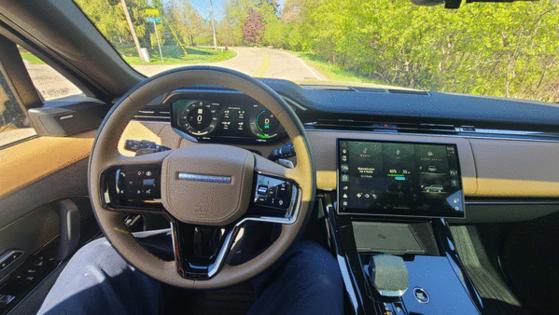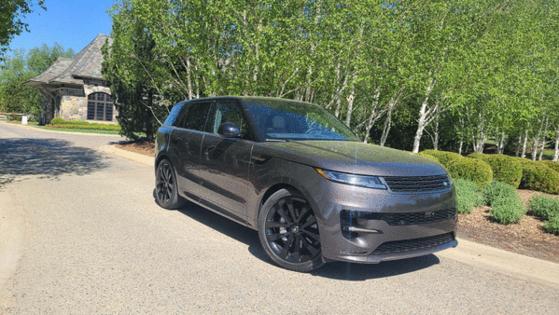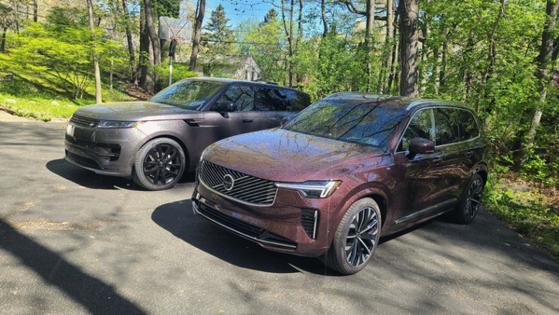Auto review: Plug-in face-off, Range Rover Sport vs. Volvo XC90
Published in Business News
OAKLAND COUNTY, Michigan — If you FOMO on BEVs but still must emit CO2 for trips, PHEV may be your GOAT.
Translation: Plug-in Hybrid Electric Vehicles (PHEV) are the new fashion statements as luxury customers face the drawbacks of BEVs (battery electric vehicles) yet still require electric for moral or convenience reasons. Two of the latest PHEVs are the handsome 2025 Range Rover Sport and Volvo XC90 T8 sitting in my driveway.
Both bring the latest digital tech, peppy drivetrains and roomy three-row cabins — wrapped in their respective, distinctive European wardrobes. Here’s how I rate ‘em after a week-long test in Metro Detroit:
Charging
Like BEVS, PHEVs are best fueled on home 240-volt charging systems. I plugged both models into my garage charger overnight for 100% battery range the next a.m. That is, 53 miles of battery-only driving for the Range Rover, 31 miles for the Volvo. That was plenty for daily errands ‘round Oakland County, but not enough for my 64-mile round trip to Detroit Metro Airport. Your range will vary depending on temperature, rain and speed.
Driving to the airport on a lovely 50-degree May morning, my XC90 T8 Ultra tester got its advertised battery range at 75 mph on the Lodge and I-94. At 33 miles, just shy of the airport, the Volvo seamlessly switched to gas-electric power without missing a stride. Inside the quiet cabin, I didn’t notice the turbo-4 engine kick in while traveling on I-94 on adaptive cruise control.
Had I been driving the Englishman (its given name, the Sport P460e Dynamic SE a typically European bowl of alphabet soup), the internal combustion mill wouldn’t have kicked in until I was halfway back home. But either way, if I wanted to drive on electrons alone, I would need to plug the two utes in at my airport parking lot, Qwikpark, and its bank of 110-volt outlets.
When I arrived at 6.40 a.m. on a Monday, there were only two spots left at the 12-space charging stable. I dragged the charging cord out of the hatchback’s sub-storage bin and ... wrong plug for the Qwikpark outlet. Back to the trunk, I found the proper, three-prong plug, and ... it didn’t work.
Every charging station is different, and Qwikpark secrets their plugs inside covered boxes to keep them out of Michigan’s elements. This box was too shallow for Volvo’s plug. Grrr. A Qwikpark airport shuttle sidled rolled up. I waved her on.
“I’m still plugging in,” I smiled, thankful I left home three hours ahead of my flight. “I’ll get the next van.”
I found another 110-volt box that has been — um, expanded by force — in order to accommodate larger connections like mine. The three-prong connector snapped into place. Phew. Of course, the beauty of PHEVs is that, even if charging failed, I would still have 497 miles of gas range in the Volvo, 4077 in the Rover.
The XC90 indicated it would take 24 hours to fill 32 miles on the 110-volt. That’s a loooooong time. No worries, though, I wouldn’t be back from my trip for 40 hours.
Driving
Assisted by battery torque and turbochargers, the internal combustion powertrains in Rover ‘n’ XC90 can really hustle. On battery power alone? Not so much.
In EV (Range Rover) and PURE (Volvo) modes, the SUVs sail along on smooth, all-wheel-drive power. But these are small batteries — 31 kWh in the Sport, 15.0 kWh in the XC90 — compared to the massive 100kWh pack in a comparable Tesla Model X or Cadillac Vistiq. So, acceleration is more of a nudge than the face-flattening ZOT! of a luxury BEV peers.
The Brit’s a bit perkier, thanks to its 2X battery capacity, but that added beef comes at a price — the 6,199-pound Rover is a 1,000 pounds heavier than EX90. That’s a lotta meat pies. No one will ever accuse Volvo of making sport utes, but the EX90 feels downright spry compared to the Rover.
When the battery runs out — or if you switch Rover to HYBRID mode — the big Brit wakes up. RAAAAWRGH! I stomped the gas pedal and the beast let out a roar from its twin-turbocharged, 3.0-liter inline-six — its formidable 454 horses vaulting past 60 mph in less than five seconds.
With 455 ponies, the Volvo is just as quick, according to our friends at Car and Driver, but gets there with a less invigorating turbo-4 banger. Hammer down, Thor!
Design
Speaking of the Scandinavian superhero, the Volvo delivers the brand’s signature Thor’s Hammer headlights combined with the expected grille bisected by Volvo’s diagonal bar logo. What’s unexpected is the new, interlaced grille logo interpretation. It’s both refreshing and more distinctive — always a welcome combination when you are paying north of $80K.
Speaking of looks, Land Rover is an industry icon. Its chiseled proportions and simple aesthetic are mimicked by brands from Ford to Jeep. The Sport ups its game inside with the usual lush materials decorated with crisp, thin digital tablets in the console and instrument display. The latter — which sems to float beneath its hood — is particularly eye-catching.
As expected at this price point, both utes are lathered with luxury features like heated/cooled seats, massaging chairs and comfortable head/legroom. The third rows? For small adults and children.
Rover and XC90 adopt monoshifters in order to save console space and accommodate wireless phone chargers and cupholders. The Volvo shows off its Scandinavian heritage with its shifter made from Orrefors glass. De-lish.
Operation
The brand’s austere design themes mean few buttons. Both brands mitigate this slight with clever visual, in-screen shortcuts to adjust, for example, temperature and drive modes. But ultimately, I learned to adjust my environment with voice commands:
Hey, Land Rover: Set driver temperature to 70 degrees
Hey, Land Rover: Navigate to CVS Pharmacy
Hey, Land Rover: Turn the radio on.
Volvo was one of the first automakers to adopt the Google Built-in operating system which accomplished the same mission. Voice commands also avoid sometimes laggy screens.
Tech
Where Range Rover separates itself from Volvo in content and price is its ridiculously capable off-road toolkit. If I owned a Sport I would take it to Holly Oaks ORV Park, select OFF-ROAD mode, finger MUD/RUTS and exercise it over the auto playground’s hills and valleys. The Brit even has a two-speed transfer case for the really sticky stuff.
If it’s bandwidth you’re looking for — six cylinders, off-road capability — Rover’s your dog. If not, both these critters will hunt just fine. Often on nothing but electric motors.
2025 Range Rover Sport PHEV
Vehicle type: All-wheel drive, five-door, seven-passenger luxury SUV
Price: $96,725, including $1,625 destination charge ($106,865 Dynamic SE as tested)
Powerplant: 3.0-liter, twin-turbocharged, inline 6-cylinder and electric motor paired with 32-kWh lithium-ion battery
Power: 454 horsepower, 487 pound-feet of torque
Transmission: Eight-speed automatic
Performance: 0-60 mph, 4.8 seconds (Car and Driver); Towing, 6,614 pounds
Weight: 6,199 pounds
Fuel economy: EPA 53 MPGe; 21 MPG (gas only); 53 miles on battery alone; 460 miles gas/electric
Report card
Highs: Gorgeous inside/out; throaty inline-6
Lows: Tight third row; gets pricey
Overall: 3 stars
2025 Volvo XC90 PHEV
Vehicle type: All-wheel drive, five-door, six-passenger luxury SUV
Price: $81,995, including $1,295 destination charge ($88,695 T8 AWD Ultra as tested)
Powerplant: 2.0-liter, twin-turbocharged, inline 4-cylinder and electric motor paired with 32-kWh lithium-ion battery
Power: 455 horsepower, 523 pound-feet of torque
Transmission: Eight-speed automatic
Performance: 0-60 mph, 4.8 seconds (Car and Driver); Towing, 5,290 pounds
Weight: 5,124 pounds
Fuel economy: EPA 58 MPGe; 27 MPG (gas only); 33 miles on battery alone; 530 miles gas/electric
Report card
Highs: Handsome new face; peppy inline-4
Lows: Tight third row; inline-4 lacks sex appeal of rest of package
Overall: 3 stars
____
©2025 www.detroitnews.com. Visit at detroitnews.com. Distributed by Tribune Content Agency, LLC.



















Comments